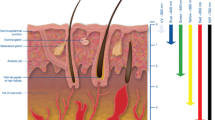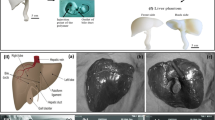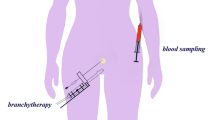Abstract
In this paper we present a simulation study of the induced specific absorption rate (SAR) within the phantom produced by radiofrequency radiation from a 8 MHz capacitive applicator. The main focus of the current study is on demonstrating the beam shaping properties of the bolus system as well as its effect on controlling the therapeutic area. Different electrical conductivities and geometries of the bolus were considered in the simulation of induced SAR distributions in a muscle-equivalent model with uniform dielectric properties. To validate the presented model, we carried out a comparison between the SAR simulation results and the temperature measurements in an agar split-phantom and an excellent agreement was observed.














Similar content being viewed by others
References
Karathanasis KT, Karanasiou IS, Uzunoglu NK (2007) Enhancing the focusing properties of a prototype non-invasive brain hyperthermia system: a simulation study. In: Proceedings of the 29th annual international conference of the IEEE EMBS, France
Chou CK, Chen GW, Guy AW, Luk KH (1984) Formulas for preparing phantom muscle tissue at various radiofrequencies. Bioelectromagnetics 5:435–441
Kumaradas JC, Sherar MD (2003) Optimization of a beam shaping bolus for superficial microwave hyperthermia waveguide applicators using a finite element method. Phys Med Biol 48:1–18
De Bruijne M, Samras T, Bakker JF, Rhoon GC (2006) Effects of water bolus size, shape and configuration on the AR distribution pattern of the Lucite cone applicator. Int J Hyperth 22:15–28
De Leeuw AAC, Mooibroek J, Wijrdeman HK, Lagendijk JJW (1994) Three dimensional SAR steering by inhomogeneous bolus loading in the coaxial TEM hyperthermia system. ESHO-94, Abstracts. The Netherlands European Society for Hyperthermic Oncology, Amsterdam, p 27
Kroeze H (2003) On the improvement of regional hyperthermia. Dissertation, University of Munich
Van Rhoon GC, Rietveld PJM, Van der Zee JA (1998) 433 MHz Lucite cone waveguide applicator for superficial hyperthermia. Int J Hyperth 14:13–27
Sherar MD, Liu FF, Newcombe DJ, Cooper B, Levin W, Taylor WB, Hunt JW (1993) Beam shaping for microwave waveguide hyperthermia applicators. Int J Radiat Oncol Biol Phys 25:849–857
Sherar MD, Clark H, Cooper B, Kumaradas J, Liu FF (1994) A variable microwave array attenuator for use with single-element waveguide applicators. Int J Hyperth 10:723–731
Kumaradas JC, Sherar MD (2002) An edge-element based finite element model of microwave heating in hyperthermia: application to a bolus design. Int J Hyperth 18:441–453
Michiyama T, Nikawa Y (2009) Simulation of SAR in the human body to determine effects of RF heating. IEICE Trans Commun 92:440–444
Field SB, Hand JW (1990) An introduction to the practical aspects of clinical hyperthermia. Taylor & Francis, Boca Raton
Wust P, Nadobny J, Felix R, Deulhard P, Louis A, John W (1991) Strategies for optimized application of annular-phased-array systems in clinical hyperthermia. Int J Hyperth 7:157–173
Wust P, Beck R, Berger J et al (2000) Electric field distributions in a phased-array applicator with 12 channels: measurements and numerical simulations. Med Phys 27:2565–2579
Das S, Clegg S, Samulski T (1999) Computational techniques for fast hyperthermia temperature optimization. Med Phys 26:319–328
Lin JC, Wang Z (2005) SAR and temperature distributions in canonical head models exposed to near and far-field electromagnetic radiation at different frequencies. Electromagn Biol Med 24:405–421
Plewako J, Krawczyk A, Grochowicz B (2005) Computer engineering in applied electromagnetism. Springer, Dodrecht, pp 337–342
Prishvin M, Zaridze R, Bit-Babik G, Faraone A (2010) Improved numerical modelling of heat transfer in human tissue exposed to RF energy. Australas Phys Eng Sci Med 33:307–317
Li Z, Vogel M, Maccarini PF et al (2011) Improved hyperthermia treatment control using SAR/temperature simulation and PRFS magnetic resonance thermal imaging. Int J Hyperth 27:86–99
Aghayan SA, Sardari D, Mahdavi SRM, Zahmatkesh MH (2013) Estimation of overall heat transfer coefficient of cooling system in RF capacitive hyperthermia. J Biomed Sci Eng 6:509–517
Kikuchi M, Amemiya Y, Egawa S et al (1993) Guide to the use of hyperthermic equipment. 1. Capacitively-coupled heating. Int J Hyperth 9:187–203
Stogryn A (1987) Equations for calculating the dielectric constant of saline water. IEEE Trans Microw Theory Tech 19:733–736
Lin JC, Wang YJ (1996) The cap-choke catheter antenna for microwave ablation treatment. IEEE Trans Biomed Eng 43:657–660
Author information
Authors and Affiliations
Corresponding author
Rights and permissions
About this article
Cite this article
Aghayan, S.A., Sardari, D., Mahdavi, S.R.M. et al. Enhancing the properties of beam forming bolus in hyperthermia: numerical simulation and empirical verification. Australas Phys Eng Sci Med 37, 691–703 (2014). https://doi.org/10.1007/s13246-014-0306-5
Received:
Accepted:
Published:
Issue Date:
DOI: https://doi.org/10.1007/s13246-014-0306-5




